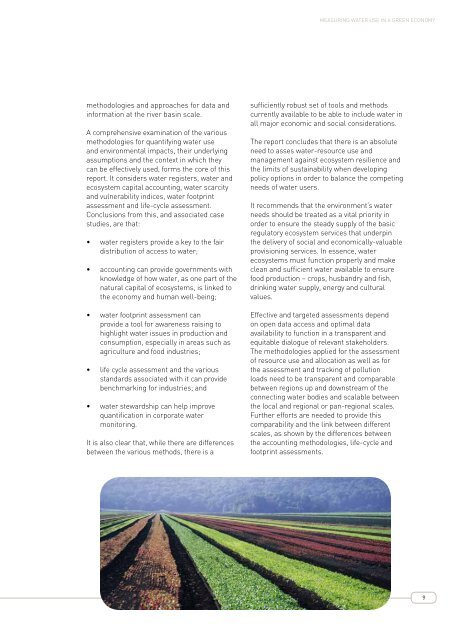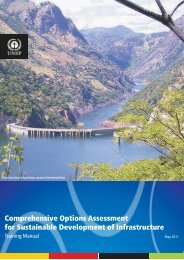MEASURING WATER USE IN A GREEN ECONOMY - UNEP
MEASURING WATER USE IN A GREEN ECONOMY - UNEP
MEASURING WATER USE IN A GREEN ECONOMY - UNEP
You also want an ePaper? Increase the reach of your titles
YUMPU automatically turns print PDFs into web optimized ePapers that Google loves.
Measuring water use in a green economy<br />
methodologies and approaches for data and<br />
information at the river basin scale.<br />
A comprehensive examination of the various<br />
methodologies for quantifying water use<br />
and environmental impacts, their underlying<br />
assumptions and the context in which they<br />
can be effectively used, forms the core of this<br />
report. It considers water registers, water and<br />
ecosystem capital accounting, water scarcity<br />
and vulnerability indices, water footprint<br />
assessment and life-cycle assessment.<br />
Conclusions from this, and associated case<br />
studies, are that:<br />
• water registers provide a key to the fair<br />
distribution of access to water;<br />
• accounting can provide governments with<br />
knowledge of how water, as one part of the<br />
natural capital of ecosystems, is linked to<br />
the economy and human well-being;<br />
• water footprint assessment can<br />
provide a tool for awareness raising to<br />
highlight water issues in production and<br />
consumption, especially in areas such as<br />
agriculture and food industries;<br />
• life cycle assessment and the various<br />
standards associated with it can provide<br />
benchmarking for industries; and<br />
• water stewardship can help improve<br />
quantification in corporate water<br />
monitoring.<br />
It is also clear that, while there are differences<br />
between the various methods, there is a<br />
sufficiently robust set of tools and methods<br />
currently available to be able to include water in<br />
all major economic and social considerations.<br />
The report concludes that there is an absolute<br />
need to asses water-resource use and<br />
management against ecosystem resilience and<br />
the limits of sustainability when developing<br />
policy options in order to balance the competing<br />
needs of water users.<br />
It recommends that the environment’s water<br />
needs should be treated as a vital priority in<br />
order to ensure the steady supply of the basic<br />
regulatory ecosystem services that underpin<br />
the delivery of social and economically-valuable<br />
provisioning services. In essence, water<br />
ecosystems must function properly and make<br />
clean and sufficient water available to ensure<br />
food production – crops, husbandry and fish,<br />
drinking water supply, energy and cultural<br />
values.<br />
Effective and targeted assessments depend<br />
on open data access and optimal data<br />
availability to function in a transparent and<br />
equitable dialogue of relevant stakeholders.<br />
The methodologies applied for the assessment<br />
of resource use and allocation as well as for<br />
the assessment and tracking of pollution<br />
loads need to be transparent and comparable<br />
between regions up and downstream of the<br />
connecting water bodies and scalable between<br />
the local and regional or pan-regional scales.<br />
Further efforts are needed to provide this<br />
comparability and the link between different<br />
scales, as shown by the differences between<br />
the accounting methodologies, life-cycle and<br />
footprint assessments.<br />
9

















